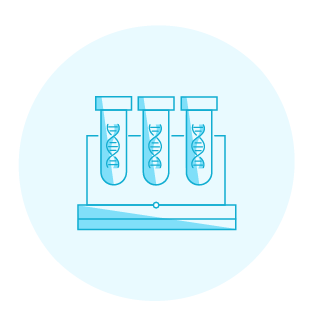What is Endocrine Genetics?

Advances in genetic testing have been crucial to the discovery of the underlying causes of several endocrine disorders. These tests act as a treatment guide and also suggest preventive measures for other family members. Genome sequencing continues to reveal the functions and dysfunctions of particular genes. Therefore, genetic tests are better especially when hormone tests provide ambiguous results. These reveal inheritable components and treatment plans for common health issues such as thyroid disease and rare adrenal tumors. Early diagnosis and treatment can significantly impact a person’s prognosis. Several molecular testing options are available in MedGenome to help in diagnostic confirmation and risk assessment for family members.
Prevalence
The genetic basis of endocrine disorders includes both monogenic as well as multifactorial or complex disorders. The disorders of the endocrine glands and tissues can be broadly grouped into: reproduction and sexual differentiation, development and growth, metabolism, regulation of nutrient supply and maintenance of homeostasis. The incidence of Disorders of Sex Development (DSD) in India ranges anywhere between 1:3000 to 1:5,500. The overall incidence of classical CAH in the general population in India ranges between 1:13000 to 1:15000 live births. Maturity Onset Diabetes in Young (MODY) is prevalence is 1:10,000 in adults and 1:23000 in children.

What are the common Genetic Endocrine Disorders?
Endocrine diseases span a vast range of conditions. Inherited endocrine disorders have a defective gene resulting in the body’s over or under-production of certain hormones. Endocrine disorders include hypothyroidism, congenital adrenal hyperplasia, etc. These common endocrine disorders can now rely on Genetic tests.
- Congenital Hypothyroidism is the partial or complete loss of function of the thyroid gland
- Thyroid dysgenesis, a cause of congenital hypothyroidism, is seen in 80 to 85 percent of cases
- Dyshormonogenesis is seen in the remainder of the cases
- If untreated, congenital hypothyroidism can lead to intellectual disability and slow growth
- Inheritance could be autosomal recessive or dominant
- The disorder can be syndromic (Pendred syndrome and brain-lung-thyroid syndrome) or nonsyndromic
- The involvement of genetic factors in obesity is estimated to be at 40% to 70%
- Monogenic obesity refers to severe early-onset obesity, associated with endocrine disorders, mainly due to mutations in obesogenic or leptogenic genes (LEP, LEPR, POMC, PC1, MC4R)
- Syndromic obesity is the condition associated with other genetic syndromes like Prader-Willi and Bardet-Biedl
- MedGenome offers a monogenic obesity panel covering a majority of single genes as well as syndromic obesity genes
Diabetes mellitus or diabetes is an etiologically heterogeneous disorder, with Type 1 and 2 diabetes mellitus being multifactorial and polygenic. Neonatal diabetes mellitus and maturity-onset diabetes of the young are the two main forms of monogenic diabetes. Maturity-onset Diabetes of the Young (MODY)
- Maturity-onset diabetes of the young is a monogenic form of diabetes characterized by a primary defect in the pancreatic ß-cell function
- This disorder has an early onset and an autosomal dominant mode of inheritance
- Though MODY can occur at any age, it is more likely to affect adolescents and young adults
- MODY is often misdiagnosed as type 1 or type 2 diabetes mellitus
- Till date, at least 13 MODY subtypes with distinct genetic etiologies have been identified
- A correct genetic diagnosis of this disorder is important as it often leads to personalized treatment for the patient and enables predictive genetic testing for their asymptomatic relatives
- Next-generation sequencing provides an efficient method for screening mutations in this form of diabetes, as well as identifying new MODY genes
Neonatal/congenital
- Neonatal diabetes is predominantly monogenic and is usually diagnosed in children under 6 months of age. The fraction of cases of this disorder without a known cause is diminishing rapidly as new genes are discovered
- The phenotype of this condition encapsulates numerous subtypes, wherein most etiologies involve a severe disruption in the ß-cell function
- This condition can be permanent and may require lifelong treatment
- At times, the condition may be transient, in which case diabetes may spontaneously remit (or be so mild as to not require treatment), but will often relapse, usually during adolescence
- Genetic testing can diagnose most forms of monogenic diabetes. If genetic testing is not performed, people with monogenic diabetes may appear to have one of the polygenic forms of diabetes. A correct diagnosis and proper treatment lead to better glucose control and improved health in the long term. The testing of other family members may also be suggested to determine whether they are at a higher risk for diabetes
- Congenital Adrenal Hyperplasia is the most common type of Disorder of Sex Development (DSD)
- CAH is a family of autosomal recessive disorders involving an impaired synthesis of cortisol from cholesterol by the adrenal cortex
- Among all CAH disorders, 21-hydroxylase deficiency (21-OHD) is the most common cause
- The diagnosis of the classic 21-OHD CAH is established in new-borns with characteristic clinical features, elevated serum 17-OHP, and elevated adrenal androgens
- Sequence analysis of CYP21A2 is performed first, followed by gene-targeted deletion/duplication analysis if only one or no pathogenic variant is found
- In almost 70% to 80% of patients, the disorder can be detected by sequence analysis while 20% to 30% may require gene-targeted deletion/duplication analysis by MLPA
- To avoid diagnostic errors, studying both parents as well as the proband is recommended to confirm the pathogenic variants and to determine if they are in cis-configuration or trans-configuration
- Androgen receptor deficiency is the second common DSD after congenital adrenal hyperplasia
- The gene encoding the androgen receptor (AR) is located on the X chromosome
- Mutations in the AR gene cause Androgen Insensitivity Syndrome (AIS), formerly known as Testicular Feminization Syndrome (TFM)
- The androgen insensitivity syndrome is an X-linked recessive disorder in which affected males have female external genitalia, female breast development, blind vagina, absent uterus, and female adnexa and abdominal or inguinal testes, despite a normal male 46, XY karyotype
- Partial androgen insensitivity results in hypospadias and micropenis with gynecomastia (Reifenstein syndrome)
- Sequence analysis by NGS can detect almost 95% to 97% of the patients with AIS
- Gene-targeted deletion/duplication analysis to detect multi-exon, whole-gene deletions or duplications may be considered if a pathogenic variant in AR is not identified by sequence analysis (3% to 5% of the cases)
- MedGenome offers MLPA technique for testing androgen receptor (AR) deletion/duplication analysis and NSG for AR next-generation sequencing analysis
- Kallmann syndrome can be characterized by delayed or absent puberty and an impaired sense of smell (hyposmia) or completely absent sense of smell (anosmia)
- This feature distinguishes Kallmann syndrome from most other forms of hypogonadotropic hypogonadism, which do not affect the sense of smell
- Many people with Kallmann syndrome are not aware that they are unable to detect odors discovered through testing
- More than 20 genes have been associated with Kallmann syndrome and mutations in the ANOS1, CHD7, FGF8, FGFR1, PROK2, or PROKR2 genes are the most common
- In some cases, affected individuals may have mutations in more than one of these genes. MedGenome offers a gene panel analysis for all the involved genes using next-generation sequencing
- Patients with lipid disorders have trouble maintaining normal levels of body fat. These disorders can be found in several conditions such as metabolic syndrome, Polycystic Ovary Syndrome (PCOS), and obesity which require special management
- Special diets, exercise, and medications may be prescribed to manage hyperlipidemia and other lipid disorders
- A familial lipid disorder is a condition that causes very high levels of cholesterol. This condition can lead to early-onset Coronary Artery Disease (CAD)
- The different types of lipid disorders include:
- Familial Combined Hyperlipidemia (FCHL)
- Familial Defective Apolipoprotein B-100
- Familial Dysbetalipoproteinemia (type 3 hyperlipoproteinemia)
- Familial Hypertriglyceridemia
- Heterozygous Familial Hypercholesterolemia
Primary causes of dyslipidemias involve gene mutations that cause the body to produce too much LDL cholesterol or triglycerides, or the failure to remove these substances. Some causes involve underproduction or excessive removal of HDL cholesterol. Primary causes tend to be inherited and thus run in families. Multi-gene panels involving all the associated genes in dyslipidemia is available for genetic testing. MLPA may be required for testing deletion/duplication in certain genes. For example, a sequence analysis of LDLR is performed first. If no pathogenic variant is found in the case of familial hypercholesterolemia, the first step is followed by LDLR deletion/duplication analysis.
Why do you need to get tested for Endocrine disorders?

It is difficult to arrive at an accurate diagnosis for endocrine disorders as the endocrine system is complex and interconnected. Derangement in any one of the glands may have its impact on other glands which may lead to difficulty in identifying the exact problem. For monogenic disorders though, biochemical testing still forms the first tier of tests, positive results only support but do not confirm the diagnosis of an underlying genetic disease. Rapid advances in testing technologies have allowed clinicians to consider genetic testing upfront both to confirm the clinical diagnosis as well as to understand disease mechanisms. A confirmed diagnosis is the first step in management and allows discussion of measures to prevent recurrences (applicable only for monogenic disorders) both for the couple as well as their respective families.
When do you need to get tested for Endocrine disorders?

- Ambiguous genitalia
- Dysgenic gonads
- Short stature
- Obesity with or without associated developmental delay
- Hyperglycemia with a strong family history
Who needs to get tested?
If your hormone levels are too high or too low, you may have an endocrine disease or disorder. Endocrine diseases and disorders also occur if your body does not respond to hormones the way it is supposed to.
Why Recommend Actia for patients with Genetic Endocrine Disorders?
Actia offers a broad range of pre-designed gene mutation panels which have been developed with in-depth disease understanding of the genetic disorder incorporating the latest research in that particular domain. New updated technologies, helpful customer service, and clear result interpretation along with genetic counselling sessions with our expert, make us equipped to provide you the best available support for your patients and families with Genetic Endocrine Disorders.
Actia offers the following endocrine gene panel tests
- Alstrom syndrome (ALMS1) gene analysis
- Androgen receptor (AR) gene analysis
- Congenital adrenal hyperplasia CYP21A2 (21-0H) gene analysis
- Congenital hypopituitarism gene panel
- Hereditary pancreatitis gene panel
- Hypercholesterolemia gene panel
- Kallmann syndrome gene panel
- Leptin deficiency (LEP) gene analysis
- Maturity-onset diabetes of the young (MODY) & neonatal diabetes gene panel
- Monogenic and syndromic obesity gene panel
What are the test methodologies?

1. Next-generation Sequencing (NGS):
Using genomic DNA extracted from blood, the coding regions of all the genes are captured and sequenced simultaneously by NGS technology on an Illumina platform. The sequence data that is generated is aligned and analyzed for sequence variants.
2. Multiplex Ligation-dependent Probe Amplification (MLPA):
Deletion and duplication analysis of genomic DNA is carried out by MLPA. This method allows for the amplification of multiple targets with only a single primer pair.
Test sample requirements
 Blood (3-5ml in EDTA tubes)
Blood (3-5ml in EDTA tubes)
Required forms
- Relevant clinical information including all the clinical presentations and symptoms
- A Test request form
Turn around time (TAT)
- 21 Working Days for NGS
- 14 Working Days for MLPA
- 21 Working Days for Sanger Sequencing
- 7-14 Working Days for Fragment Analysis
- 8-15 Working Days for Karyotyping
 Extracted DNA samples (1µg high-quality DNA)
Extracted DNA samples (1µg high-quality DNA)
GET GENETIC COUNSELLING
Actia offers all your patients pre and post-test genetic counselling with our expert and certified genetic counsellor We provide the best available support for your patients and families via
- Latest technologies
- Helpful customer service
- Clear result interpretation
- Counselling sessions with our genetic counsellor


 Enquire
Now
Enquire
Now